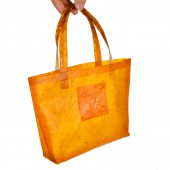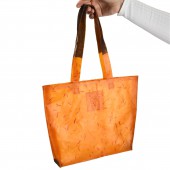SeeTang Collection Biomaterial Invention by Jana-Aimee Wiesenberger |
Home > Winners > #131585 |
 |
|
||||
| DESIGN DETAILS | |||||
| DESIGN NAME: SeeTang Collection PRIMARY FUNCTION: Biomaterial Invention INSPIRATION: Raising awareness about marine conservation and the important role of microalgae and macroalgae for the health of our planet inspired SeeTang. Plastic pollution in the Fashion and Packaging industry influenced the project outcome. SeeTang instant dish showcases a biodegradable alternative to plastic polluted food packaging. SeeTang fashion collection offers a saffron-infused bioplastic alternative to single-use grocery bags. UNIQUE PROPERTIES / PROJECT DESCRIPTION: SeeTang Collection was designed sustainably to introduce invented biomaterials. The products are focused on marine conservation. Packaging: The inner packaging is cooked alongside the main ingredients as the biomaterial is edible and dissolvable in water. The outer packaging is either recyclable or can be put in the compost. Fashion: The biomaterial is infused with saffron dye. The colour is inspired by the grocery store Sainsbury's. The collection showcases alternatives to plastic bags. OPERATION / FLOW / INTERACTION: SeeTang instant dish is cooked with all packaging included except for the outer packaging. The outer packaging is either recyclable or can be put in the compost where it will biodegrade. The outcome is a zero-waste instant dish for a non-plastic alternative. SeeTang fashion is durable and long-lasting while being biodegradable, sustainable, recyclable, vegan and edible. PROJECT DURATION AND LOCATION: The project started in Mai 2021 and finished in September 2021. |
PRODUCTION / REALIZATION TECHNOLOGY: Focused on marine conservation the biomaterials are sourced from the sea to raise awareness about their importance to our climate and planet. Plastic pollution in the Fashion and Packaging industry influenced the project outcome. SeeTang bioplastic is made from algae and dyed with natural colours like avocado skin and stone, onion skin, hibiscus, coffee and saffron. The production of SeeTang is a zero-waste process. SPECIFICATIONS / TECHNICAL PROPERTIES: Instant dish: 15cm x 2cm x 15cm Hand bag #1: 24cm x 5cm x 29cm Small bag #2: 20cm x 5cm x 17cm Instant dish bag: 19cm x 0,5cm x 31cm TAGS: Biodesign, Biomaterial, Bioproduct, Bioplastic, Sustainability, Environmental Design RESEARCH ABSTRACT: To fully understand my field of study, marine organisms, and plastic pollution, I achieved a Level 3 Diploma in Marine Biology. Additionally, I talked to different seaweed harvesters in the UK about their work and how it positively affects the health of marine life. Furthermore, I conducted a workshop with different designers to understand how far I could push the biomaterials. In total, I experimented with 36 different biomaterial solutions to finalise the best bioplastic for the outcome. CHALLENGE: The biggest challenge of this project was to accept the newly invented biomaterial with all its attributes, positive or negative. In the beginning, I tried moulding the material and shaping it, however, this is not possible due to its drying process characteristics. Furthermore, I had limited facilities to manufacture materials & products due to Covid-19 restrictions. All materials and products were produced in my kitchen. ADDED DATE: 2021-09-30 14:22:09 TEAM MEMBERS (1) : Jana-Aimée Wiesenberger IMAGE CREDITS: Jana-Aimee Wiesenberger, 2021. |
||||
| Visit the following page to learn more: http://bit.ly/3CS8QH0 | |||||
| AWARD DETAILS | |
 |
Seetang Collection Biomaterial Invention by Jana-Aimee Wiesenberger is Winner in Sustainable Products, Projects and Green Design Category, 2021 - 2022.· Press Members: Login or Register to request an exclusive interview with Jana-Aimee Wiesenberger. · Click here to register inorder to view the profile and other works by Jana-Aimee Wiesenberger. |
| SOCIAL |
| + Add to Likes / Favorites | Send to My Email | Comment | Testimonials | View Press-Release | Press Kit |







